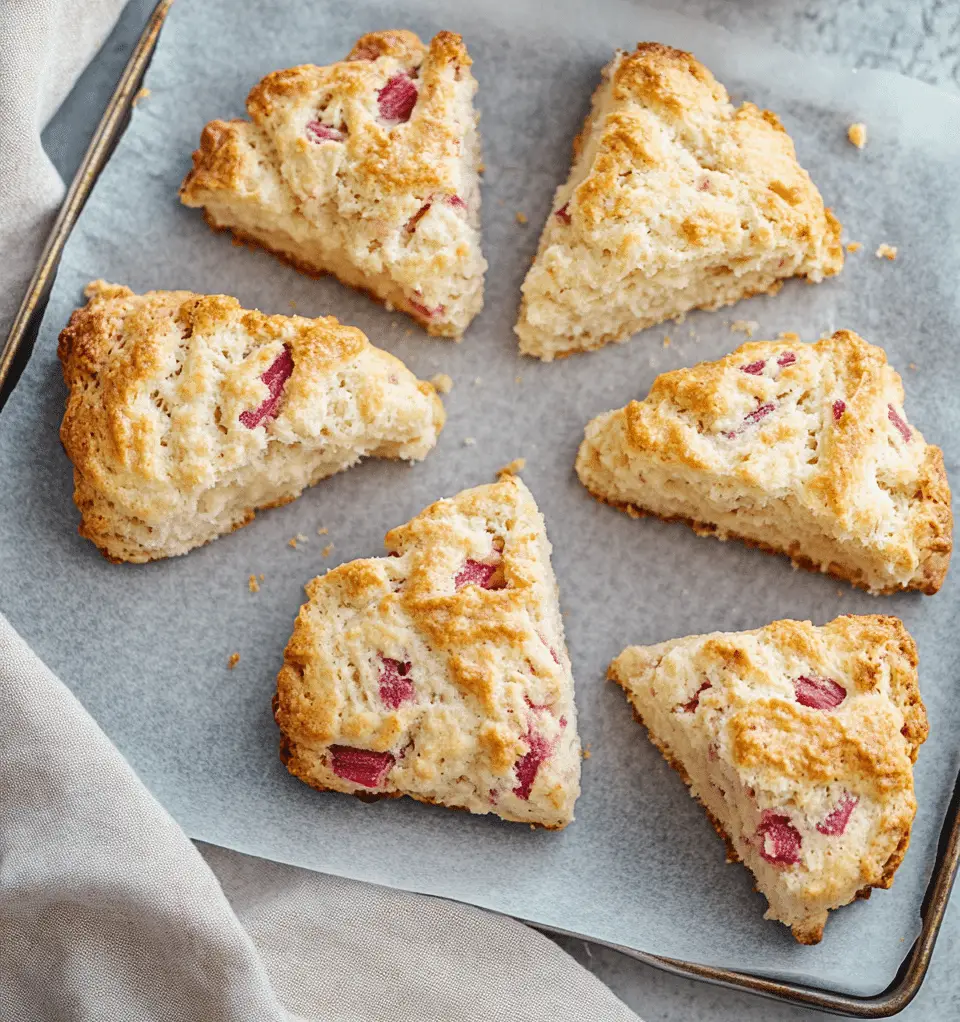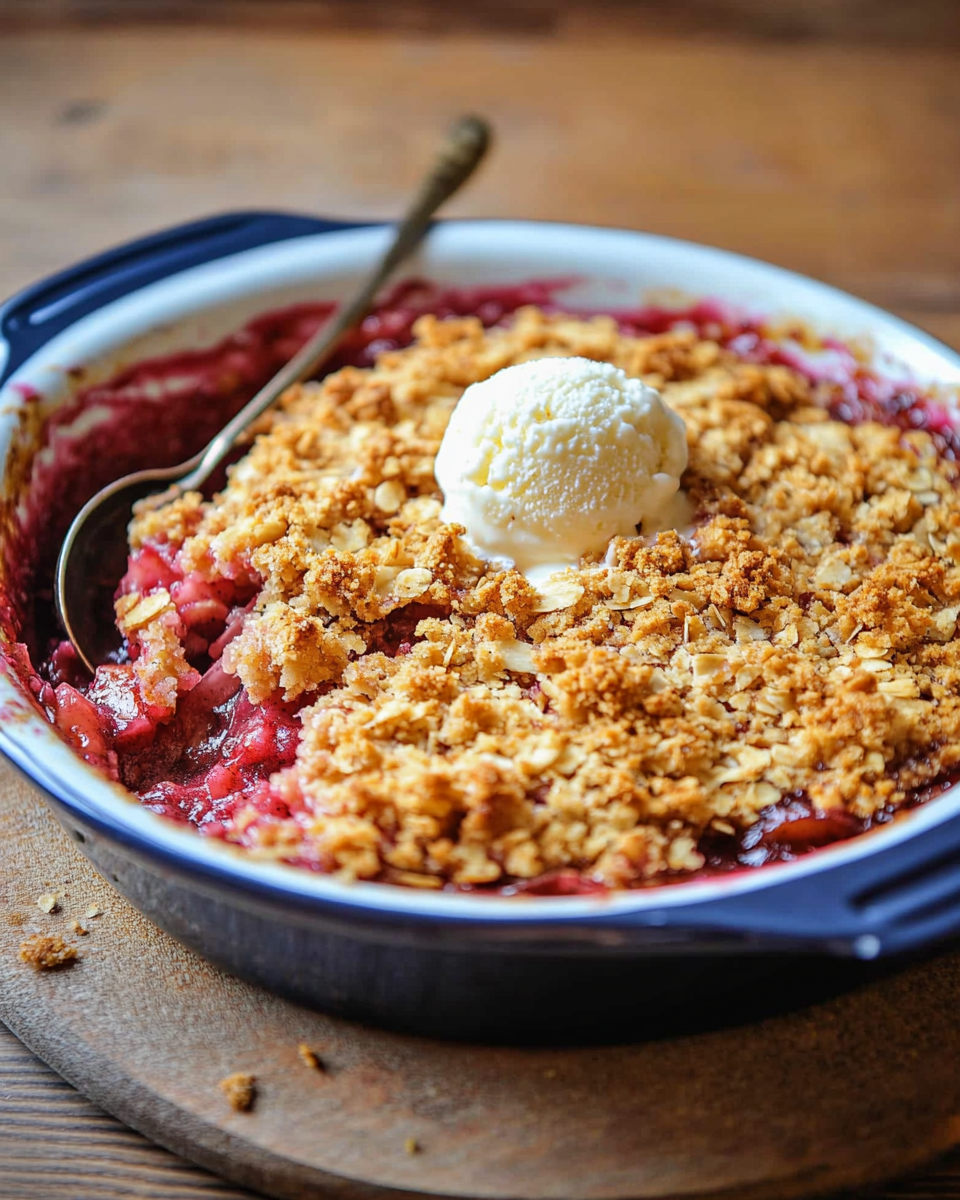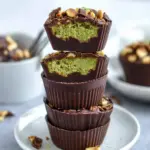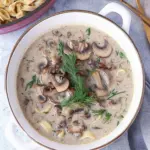A tangy and creamy delight, this rhubarb ice cream combines the tartness of rhubarb with a rich, smooth texture, making it a perfect refreshing dessert for warm days.
FULL RECIPE
Ingredients
- 2 cups chopped fresh rhubarb
- 3/4 cup granulated sugar (divided)
- 2 cups heavy cream
- 1 cup whole milk
- 4 large egg yolks
- 1 teaspoon vanilla extract
- Pinch of salt
Directions
- In a medium saucepan, combine the rhubarb and 1/4 cup sugar. Cook over medium heat until the rhubarb softens and breaks down, about 10 minutes. Let cool, then puree in a blender or with an immersion blender.
- In another saucepan, heat the cream and milk until just simmering.
- In a bowl, whisk the egg yolks with the remaining 1/2 cup sugar until pale and slightly thickened.
- Slowly pour the hot cream mixture into the yolks, whisking constantly to temper the eggs. Return the mixture to the saucepan.
- Cook over low heat, stirring constantly, until the custard thickens enough to coat the back of a spoon (170–175°F). Do not boil.
- Remove from heat and stir in vanilla extract and a pinch of salt.
- Allow custard to cool slightly, then mix in the rhubarb puree.
- Chill the mixture thoroughly in the refrigerator, at least 4 hours or overnight.
- Freeze in an ice cream maker according to manufacturer instructions. Transfer to a container and freeze for at least 2 more hours before serving.
Nutritional Information
- Calories: 220
- Total Fat: 16g
- Saturated Fat: 10g
- Cholesterol: 125mg
- Sodium: 40mg
- Total Carbohydrates: 15g
- Dietary Fiber: 1g
- Sugars: 14g
- Protein: 3g
The History of Rhubarb in Desserts
Rhubarb has a rich history as a versatile ingredient in desserts dating back centuries. Originally native to Asia, it was prized for both its medicinal properties and its tart flavor. European settlers brought rhubarb to the Americas, where it became a popular fruit substitute in pies, tarts, and compotes. Its natural tartness pairs beautifully with sugar and cream, making it a favored ingredient for sweet treats like ice cream. Over time, rhubarb ice cream emerged as a unique twist on traditional ice cream, combining the refreshing tang of rhubarb with the creamy texture of dairy.
Why Rhubarb Works Perfectly in Ice Cream
The tartness of rhubarb provides a lively contrast to the richness of cream and egg yolks used in ice cream custards. This balance prevents the dessert from becoming overly sweet or heavy. The natural acidity of rhubarb also brightens the overall flavor profile, giving each bite a fresh and slightly tangy finish. When pureed and mixed into the custard base, rhubarb imparts a subtle pink hue that enhances the visual appeal of the ice cream.
The Science Behind Making Custard-Based Ice Cream
Creamy rhubarb ice cream is based on a classic custard, which involves cooking egg yolks with milk and cream to create a smooth and rich base. The science lies in gently heating the eggs so they thicken the mixture without curdling. This process, called tempering, requires slowly combining hot dairy with eggs to avoid scrambling. The resulting custard freezes into a creamy texture because the fat from the cream and eggs inhibits ice crystal formation, giving ice cream its signature smoothness.
Health Benefits and Nutritional Aspects of Rhubarb
Rhubarb is a low-calorie vegetable that provides beneficial nutrients including vitamin K, calcium, and fiber. It also contains antioxidants that may help reduce inflammation. While rhubarb stalks are edible, the leaves are toxic and should never be consumed. Incorporating rhubarb into ice cream adds a small nutritional boost compared to traditional flavors, especially by contributing dietary fiber and antioxidants. However, this ice cream still contains significant fats and sugars, so it is best enjoyed as an occasional treat.
Seasonal Availability and Choosing Fresh Rhubarb
Rhubarb is typically in season from early spring through early summer, making it a fresh and vibrant ingredient during those months. When selecting rhubarb, look for firm stalks that are brightly colored — usually red or pink — with minimal blemishes. Avoid stalks that are limp or show signs of mold. Fresh rhubarb will provide the best flavor and texture for your ice cream. Outside of its season, frozen rhubarb can be used but may require slight adjustments in cooking time during preparation.
Variations on Rhubarb Ice Cream
While the classic recipe blends pureed rhubarb into a vanilla custard base, there are many ways to customize this dessert. Some variations include adding complementary fruits like strawberries or raspberries to create a mixed berry rhubarb flavor. Others experiment with spices such as ginger, cinnamon, or cardamom to add warmth and depth. For a lighter version, yogurt or coconut milk can be used instead of heavy cream. Swirls of rhubarb compote or crumble toppings add texture and extra flavor contrast.
Pairing Rhubarb Ice Cream with Other Desserts
Rhubarb ice cream is wonderfully versatile and pairs well with many other desserts. It complements warm fruit pies, especially apple or berry pies, by adding a cooling contrast. It can also be served alongside pound cake, shortbread, or gingerbread for a delightful combination of creamy and crumbly textures. For a more decadent option, drizzle the ice cream with a caramel or honey sauce to balance the tartness with sweetness. Rhubarb ice cream also pairs well with fresh fruit salads or as a topping for waffles and pancakes.
Tips for Storing and Serving Rhubarb Ice Cream
To maintain the creamy texture and flavor of rhubarb ice cream, store it in an airtight container in the freezer. Pressing a piece of parchment paper directly onto the surface before sealing helps prevent ice crystals from forming. When serving, allow the ice cream to soften slightly at room temperature for a few minutes to make scooping easier. Using a warm scoop can also help form smooth, clean scoops. For an elegant presentation, garnish with fresh rhubarb ribbons or a sprig of mint.
The Role of Sugar in Balancing Tartness
Sugar plays a crucial role in this recipe by balancing the natural tartness of rhubarb and enhancing its fruity flavor. Without enough sugar, the ice cream can taste overly sour or sharp. However, too much sugar can overpower the rhubarb’s delicate flavor and make the ice cream cloying. The recipe’s balance is designed to keep the dessert pleasantly sweet yet tangy. Additionally, sugar lowers the freezing point of the ice cream mixture, contributing to a softer, scoopable texture.
Cultural Significance and Popularity of Rhubarb Desserts
In many cultures, rhubarb desserts have a nostalgic quality, often associated with springtime and family gatherings. In parts of the UK and Northern Europe, rhubarb is sometimes called “the pie plant” because of its popularity in baked goods. Rhubarb ice cream, while less traditional, has gained popularity in recent years as artisan ice cream makers and home cooks explore creative flavor combinations. Its unique tartness offers an alternative to overly sweet commercial ice creams, appealing to those who enjoy complex flavors.
How to Adapt This Recipe for Dietary Restrictions
This creamy rhubarb ice cream recipe can be modified to accommodate various dietary needs. For a dairy-free version, substitute coconut milk or almond milk and use a suitable egg replacer or thickener like cornstarch to mimic the custard base. To reduce sugar, natural sweeteners such as stevia or erythritol can be used, although texture and sweetness levels might vary. For those avoiding eggs, a no-cook method using gelatin or agar agar can help achieve creaminess. These adaptations make the dessert accessible while maintaining much of its signature flavor.
The Art of Balancing Texture and Flavor in Homemade Ice Cream
Achieving the perfect texture in homemade ice cream requires attention to both flavor balance and freezing technique. The fat content from cream and egg yolks lends richness and smoothness, while the rhubarb puree adds slight graininess and freshness. Chilling the custard thoroughly before freezing and using a quality ice cream maker are essential steps to prevent ice crystals. Incorporating the rhubarb at the right stage ensures the flavor is evenly distributed without overpowering the creamy base.
Conclusion
Creamy rhubarb ice cream is a delightful dessert that brings together the best of tart and sweet flavors with a luxurious texture. Its roots in traditional rhubarb desserts give it a nostalgic appeal, while the custard base showcases the science behind smooth, homemade ice cream. Whether enjoyed on its own or paired with other sweets, this ice cream offers a refreshing alternative to classic flavors. Its versatility, nutritional benefits, and seasonal appeal make it a favorite among home cooks and dessert lovers alike, perfect for celebrating the rhubarb harvest or simply indulging in a unique frozen treat.








